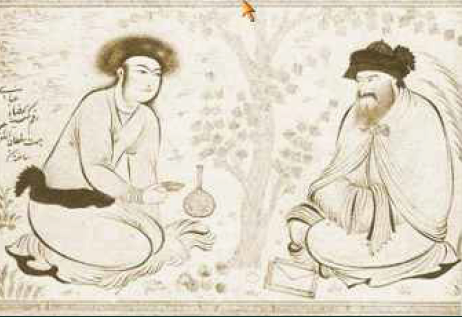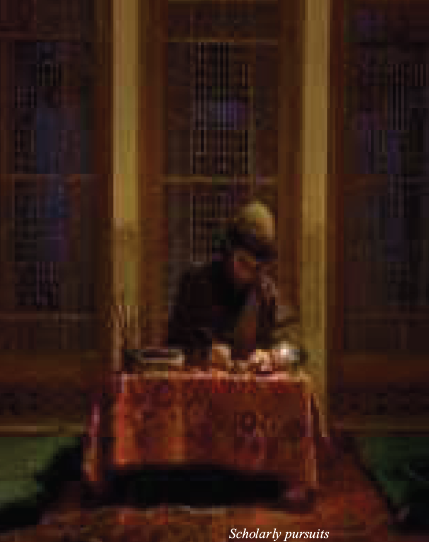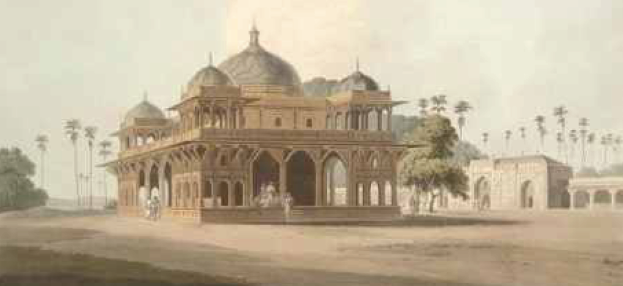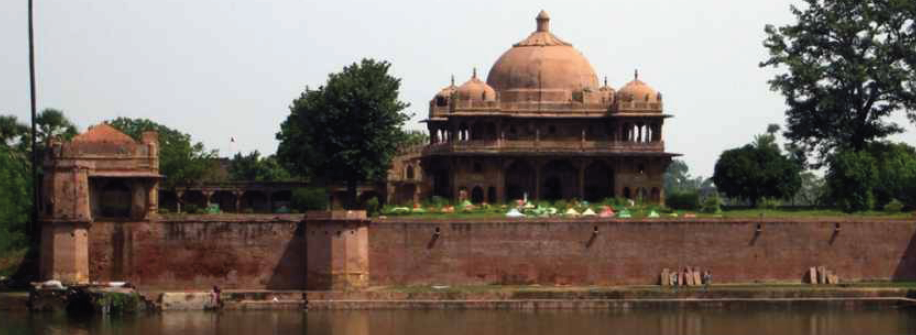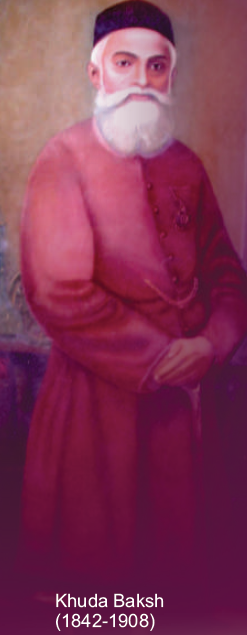Bihar Sharif
This is a collection of articles archived for the excellence of their content. Readers will be able to edit existing articles and post new articles directly |
Bihar Sharif
By Kulsoom Noor Saifullah
Walking with the Sufis
India Harmony VOLUME - 1 : ISSUE - 6 SEPTEMBER-OCTOBER, 2012
“One day I will have to go and leave this burden behind, except for your name, nothing will be found in my record”
So wrote Sharafuddin Maneri, the much revered medieval saint of Bihar in Maktubat-e-Sadi or “Hundred letters of the century”. So rich was this collection of letters in philosophy and wisdom, that over the centuries they have been preserved, read, discussed and taught at diverse spiritual centres across the world.
Sufism came early to Bihar, as early as the twelfth century, in the wake of the Afghan incursions into North India. One of the earliest Sufis to settle in India was the great Sufi saint Moinuddin Chishty of Ajmer. His followers, at his behest, fanned out all over the country to spread the message of peace and brotherhood. These were highly enlightened, scholarly men with only one mission-the propagation of divine love. Their creed was the universality of religion and they came to India to escape from the religious orthodoxy whose writ ran large over the lands of Central Asia. Indeed, the word “sufi” or “wool” stands for the rough sheep's wool cloaks that these monks wore and the uniformity of their dress gave them the common name of Sufis. They were ascetics and wandered across northern India contemplating learning, teaching. The Bihari Sufis came to believe that “Everything is He” and reconciled religion with philosophy. This was welcomed by the local populace who understood the doctrine of respect for all faiths only too well. After all, they belonged to the land of Mahavira, Buddha and Ashoka, besides being deeply rooted in the Vedantic philosophy of the early Aryans.
In 1202 AD, when the dashing Turk Bakhtiar Khilji swept through Bihar establishing the rule of the Delhi Sultans, he brought in his entourage his spiritual advisors, the Sufis, who put down their roots here. Persian then became the preferred language of the court, the administration, the Khanqahs and the Madrassas that came up across territory that was once the ancient Magadh Empire (322-185 Bc). Persian influence was not new to Bihar The Influence of earlier Iranic empires could be seen in the palace ruins of Patliputra which exhibited the “conscious adoption of the Iranian palace plan by the Mauryas as also distinct influences of the art of the Archemedial Empire”. Throughout the Delhi Sultanate period (1206-1526) and throughout Mughal rule (1526-1857), the Persian language reigned supreme. It became the preferred language of the sufis too and this gave rise to the most outstanding works of literature, history and spirituality during that period.
One of the earliest and most revered of the sufis to put down roots here was Sheikh Kamaaluddin Yahya Maneri who established a centre of learning visited by many scholars from distant lands. He was the grandson of Hazrat Imam Taj Faquih Hashmi (who also came to be known as Sheikh al Hind) who had settled in Maner, a small settlement 29 km from Patna. The family, originally from Palestine, were disciples of Sheikh Umar-al-Suhrawardi of Iraq, founder of the Suhrawardiyya sufi order. Sheikh Yahya Maneri was sent to study theology at Baghdad Academy and on his return to Maner married the daughter of another great spiritual saint and Prince of Kashghar region Makhdoom Pir Jagjot. He together with Sheikh Yahya Maneri and other Sufi scholars established Maner or Phulwari Sharif as it is also known, as a centre of religious learning unparalleled at that time. Over the centuries the social and cultural developments that emanated from the message of love and tolerance preached by the Sufis became a way of life for the people of Bihar.
The spiritual centre at Maner Sharif attracted kings and commoners, Hindus and Muslims alike. It's renown brought royal visitors such as Sikandar Lodi and Babur, the great Moghul himself, to their dargahs to seek the blessings of these highly enlightened souls. It's rich architectural past is evident today in the red sandstone Shah Sangi Masjid built by the Emperor Humayun in honour of the spiritual masters. Also still standing in modern times are the Khanqah Mujeebia, Sheesh Mahal and Imarate Sharia, memorials to the birth and development of the sufi culture in India.
In 1263 AD a son was born to Sheikh Yahya Maneri, a child who was to grow up to be one of Bihar's most revered and beloved of sufi saints, Sheikh Sharafuddin Ahmed Yahya Maneri. He exhibited an interest in spirituality and scholarly pursuits from his early childhood. It is said that his mother saw a divine presence bending over the baby's cradle. She reported the matter to her father who himself was an evolved soul. Her father was overwhelmed by the news of the visitor and told her that her baby was greatly blessed and would one day be a man of great spiritual powers. This soon became evident as the boy became proficient in Arabic, Persian, logic, philosophy and religion under a renowned teacher in Sonargaon near Dacca. He married his teacher's daughter and a son was born to them. However, soon after the birth, he left home to pursue his thirst for spiritual knowledge and in search of a spiritual mentor. His search took him all over the country including the Khanqah (seminary) of Hazrat Nizamuddin Aulia at Delhi. He finally found his mentor in Najamuddin Firdausi (near Delhi) who initiated him into the sufi order and declared him his successor on earth. Sharafuddin Maneri established the Firdausi order in his mentor’s name. His mentor instructed him to return to Bihar. Sheikh Maneri retreated to the Rajgir hills and spent long years in contemplation, near a hot spring which is now called Makhdoom Kund in his memory. Having spent thirty years in the woods near Rajgir, where Buddhist monks and Hindu sages had also sought enlightenment in ancient times, he returned to Bihar Sharif where he devoted the rest of his life to teaching and writing. These teachings are embodied in several collections of letters to his disciples, state dignitaries and also to Sultan Firoz Tughlaq. His books Maktoobate Sadi (hundred letters of a century) and Maktoobate do Sadi (two hundred letters of a century) are renowned collections of spiritual writings in the Persian language. They have since been translated into English by P. Jackson and are appreciated by an international readership. The original manuscripts are preserved in the Khuda Baksh library at Patna.
In his writings and discourses, he discussed the spiritual duties of Islam and the moral, social and ethical responsibilities of Muslims. He believed that mystical knowledge was the seed of love and exhorted his followers to surrender to the divine fire which consumed despondency and desperation. He lit the lamp of hope and love in his believers. He was well-versed in teachings of all faiths and was a repository of esoteric knowledge and was known to possess supernatural powers. Just before his death, he chose his successor, bestowed his patched sufi cloak on him, and dictated his funeral prayer and then passed on to another realm. His shrine became a place of sanctity and prayer for all time to come drawing believers of all faiths who visit to this day asking for boons and blessings. Seven hundred years later he is still known as Makhdoom-ul-Mulk (Master of the world) Makhdoom-e-Jahan (Master of the Universe) and most eardearingly by the Bihari people, as their very own beloved Sharfa Bihari.
The Khuda Baksh Library
Patna was a famous centre for Persian and Arabic studies so much so that in 1772 Raja Ram Mohan Roy was sent there to acquire proficiency in the language. Having mastered the language he composed the “Tohfat–al–mowabedin” in Persian with a foreword in Arabic. The all pervading influence of the language attracted both hindu and muslim scholars. Many Hindu authors attained eminence with their literary works such as Raja Ram Narayan “Mauzoon” whose correspondence with his tutor Sheikh Ali Hazin is notable. Raja Peare Lal ‘Olfati’ was a famous ghazal singer also known for his matnavi and neyrang-e-taqdeer. His maternal grandfather Raja Ojagarchand “Olfat” has left two of the finest collections of ornately written letters in addition to his Diwan. Patna was a renowned center for ivory painting with rendering of birds, animals and human figures showing persian influence. Persian Calligraphy was highly prized and Iza-al-din, a great calligrapher of that time produced specimens of various forms of scripts. Buchanan’s map of Patna dated 1812 is in Persian showing the use of Persian even under British rule. In the early 20th century, a Hindu lawyer, Baijnath Singh translated some of Maneris’s writings from Persian to English. In the twenty first century too Patna is home to renowned scholars of Urdu and Persian who have benefitted from a vast collection of documents, scripts, paintings etc. that have been lovingly displayed by the great collector Khuda Baksh whose priceless gift to the nation is the Khuda Baksh Oriental Public Library at Patna.
Principles of Sufism
Zekhr - to remember - remembering God at all times Fekr - to think, meditate - being in the state of awareness and wondering Sahar - to awaken - awakening of soul and body Jui’ - to hunger - having exterior hunger (mind) and interior hunger (heart) to obtain the truth and to persist in the search Somt - to observe silence - ceasing to think and talk about worthless things Saom - to fast - fasting of body from food, mind from attachments, and soul from desires Khalvat - to observe solitude - praying in solitude, externally and internally Khedmat - to serve - dissolving in the Truth of the master and dissolving in the Truth of existence, God.
Principles of Vedanta
In the highest sense, Vedanta means knowledge of God or the Absolute Reality, as recorded in the Upanishads, the final section of the Vedas. This knowledge is not acquired by education, nor by adherence to scripture. Instead, Vedanta declares that it is the goal and birthright of every individual to obtain this knowledge through direct experience. To reach this goal, Vedanta gives us principles which can guide us in our approach to life, in affirming that the universe is a manifestation of one Spiritual Reality. Within each person this Divine Essence is at the core of his or her innermost being. Thus human life becomes an opportunity to unfold and manifest this Divinity from within. All religions are valid paths which can lead one to the realization of these truths.
Principles of Buddhism
The Noble Eightfold Path Right Understanding Right Thought Right Speech Right Action Right Livelihood Right Effort Right Mindfulness Right Concentration
